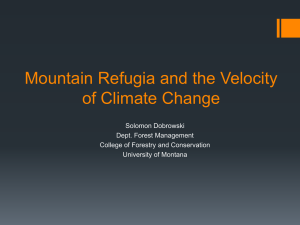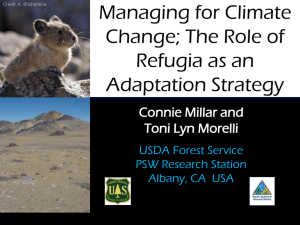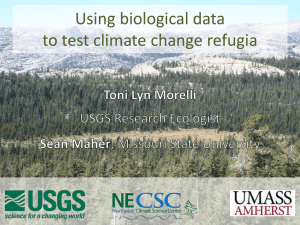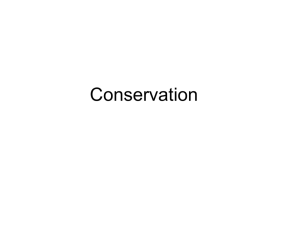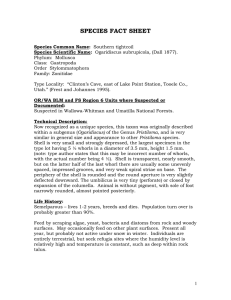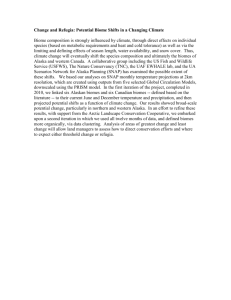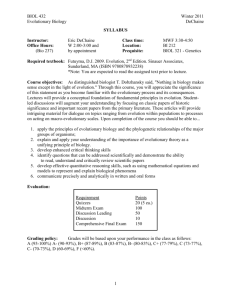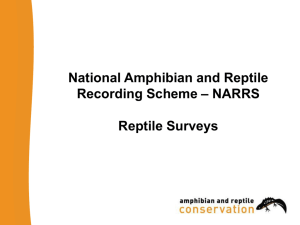NPS Climate Change Response Leadership: Service Wide, Regional, and @
advertisement
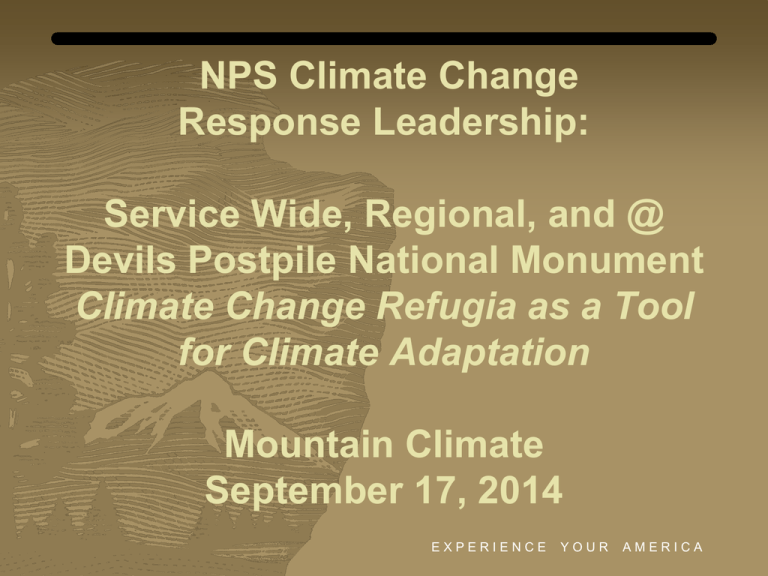
NPS Climate Change Response Leadership: Service Wide, Regional, and @ Devils Postpile National Monument Climate Change Refugia as a Tool for Climate Adaptation Mountain Climate September 17, 2014 EXPERIENCE YOUR AMERICA Devils Postpile National Monument Conservation and Climate Challenges = Extraordinary Opportunities Nestled near the Sierra Divide, Near Headwaters of the San Joaquin River YOSE DEPO SEKI Ecotone Of Great Basin starting at Eastern Sierra And West Slope Sierra Nevada Devils Postpile : Near Headwaters & Importance of the San Joaquin River ■ DEVIL’S POSTPILE ■ ■ Upper Middle Fork of the San Joaquin River One of two largest rivers in California Important source of water for agriculture, hydropower, drinking water EXPERIENCE YOUR AMERICA Geographic Context ■ ■ ■ ■ ■ Surrounded by Inyo NF Gateway to over 2 million acres of wilderness; 80% designated wilderness John Muir Trail and Pacific Crest Trail Part of a broader visitor experience On Sierra Hydrological Divide “Scientific Value and Public Interests” On July 6, 1911 DEVIL POSTPILE NATIONAL MONUMENT CALIFORNIA Was designated to : Preserve the natural formations known as the Devil Postpile and Rainbow Falls for their scientific value and public interest EXPERIENCE YOUR AMERICA Purpose of Devils Postpile N.M. Preserves and protects the glacially exposed columns of the Devils Postpile, the scenic Rainbow Falls, and the wilderness landscape of the upper Middle Fork San Joaquin River in the Sierra Nevada for scientific value, public interest and inspiration. GMP: FRVs/Desired Conditions related to Climate Change ❖ Upper Middle Fork of San Joaquin river, riparian corridor, and wetlands ❖ Component of larger ecosystem ❖ Opportunities for Science and Learning EXPERIENCE YOUR AMERICA DEPO Science Day as part of GMP planning, and de facto Science Technical Committee Desired Conditions Potential Management Actions /Common All Alternatives The NPS continues to Provide and foster stateof-the art science to better understand the impacts of climate change and to develop science-based adaptive management strategies for natural and cultural resource managers. Develop and sustain a historical archive of the climate, weather, hydrologic and ecological conditions in the past, present, and future and integrate these disciplines to feed into modeling, adaptation strategies and mitigations. The NPS engages in partnerships to implement projects and activities that contribute to the conservation of species, natural communities, and lands and waters placed at risk by changing climate conditions. Seek research opportunities with agency and academic partners to improve understanding of effects of climate within monument and watershed. FRV: Upper Middle Fork San Joaquin River (corridor): A free flowing river, wetlands, riparian areas and other and communities. Potential Activity: implement projects and activities that contribute to the conservation of species, natural communities, and lands and waters placed at risk by changing climate conditions. Soda Springs Meadow Provide and foster state-of-the art science to better understand the impacts of climate change and to develop science-based adaptive management strategies Wetland Inventory and Condition Assessment NPS- 2008 8.0% of monument wetlands (other areas in SIEN average 2%) Potential Activity Develop and sustain a historical archive of the climate, weather, hydrologic and ecological conditions in the past, present, and future and integrate these disciplines to feed into modeling, adaptation strategies and mitigations Mammoth Gap receives higher precip The high amount of precipitation that comes up the SJ Valley and hits Mammoth Mountain that runs S. as surface water in creeks and and SWE than other Sierra points, springs, and groundwater that nourishes meadows and seeps. and known for only E. Sierra Red Fir. Why is there such a high % of wetlands. Some factors may include : *The high amount of precipitation that comes up the SJ Valley and hits Mammoth Mountain that runs as surface water in creeks and springs, and groundwater that nourishes meadows and seeps. Snow percolating through porous volcanic rock contributes to high % of wetlands and springs *Possible cold air pooling in the valley with reduction in evaporation. San Joaquin River Valley under 10K corridor along ecotone and high biodiversity 2001 Vascular Plant increased known species from 150: to 380 800 acres/less than 1000 foot elevation range Additional Inventories included: Invertebrates 100+ Genus, 100+Species of Birds 33 Vertebrates EXPERIENCE YOUR AMERICA I Cool, Wet, Shady longer Surrounded by High Peaks Ice box Canyon…. Climate Change in California: Cause for Concern Increasing Temperatures, Decreasing Precipitation By 2050, temperatures are projected to increase an additional 1.8 to 5.4 °F;-Temperature changes in next 30-40 years largely determined by past emissions. Warming will accelerate mid-century to end of century. August 2014, California has been classified by the US Drought Monitor as experiencing severe, extreme, or exceptional drought, including the Sierra Nevada to be in the highest category of exceptional drought. Impacts on the Sierra Nevada : Cause for Concern Precipitation ■ Hotter, Drier= ■ Shrinking Sierra snowpack= greater water deficit during the seasonal summer drought ■ Ecosystems and species stressed by water deficit ■ EXPERIENCE YOUR AMERICA Impacts on the Sierra Nevadas : Snowpack A Conservative climate model predicts a 30 –70% reduction in seasonal snowpack while another predicts a 73 – 90% reduction by the end of this century. Faster spring snowmelt Decrease in spring and summer flows EXPERIENCE YOUR AMERICA Sierra Nevadas : Impacts on Flora and Fauna Phenology – The timing of life cycle events influenced by seasons and climate. Example : The Spring Snowmelt Recession EXPERIENCE YOUR AMERICA Sierra Nevadas : Impacts on Flora and Fauna ■ ■ ■ Changing habitat variables Extinction Invasive species Highly flexible and adaptable ■ EXPERIENCE YOUR AMERICA Sierra Nevadas: Forests Climate change interacts with: Fire Fire suppression policies Insect infestations Pathogens Drought Figure source: Allen et al. 2010: A global overview of drought and heatinduced tree mortality reveals emerging climate change risks for forests. http://nca2014.globalchange.gov/report/sectors/forests http://www.fs.usda.gov/Internet/FSE_DOCUMENTS/stelprdb5415086.pdf EXPERIENCE YOUR AMERICA Sierra Nevadas : Forests Example : Mountain Pine Beetle Dendroctonus ponderosae Photo : http://www.fs.usda.gov/Internet/FSE_MEDIA/stelprdb5415084.jpg EXPERIENCE YOUR AMERICA Is California’s Current Drought Caused by Climate Change?????? California is in a ThreeYear Drought Water Year vs. Calendar Year 100% of California in the Three Highest Intensities of Drought State of Drought Emergency declared by the governor in January, US Drought extreme in August. Whether current drought from CC, the current snowpack situation, droughts, and extreme weather events will become more common in the future. And the impacts of drought are more severe with a warmer climate. Historical 10th percentile 2014: April 1st snowpack survey at 38% average in DEPO/Central Sierra Impacts to DEPO from CC 1. Impacts to Riparian corridor of the Middle Fork San Joaquin River and associated wetland habitats. 2. Increased Air Pollution and impacts to vegetation and wildlife. 3. Impacts to most important meadow: Soda Springs 4. Fire frequency and severity. 5. Vulnerability to invasive species. 6. Extended visitation season, greater numbers of visitors, more impacts EXPERIENCE YOUR AMERICA Priorities Each of the six concerns are of high importance. Fortunately, three of the concerns are being addressed by intensifying efforts with existing programs to increase resilence of ecosystems in response to climate. Invasive removal with 2 resource positions and volunteers Visitor Impacts with indicators and standards for extent social trails and mitigation measures. , ■ Fire EXPERIEN C E Yreduction O U R A M E R Iwith CA and hazard fuel Planned hazard fuel reductions with pile burning implemented March 2014 E X P E R I EBroadcast N C E Y Oburn plan 2015 to 2016 Unprecedented Challenge & Extraordinary Opportunity: After addressing Resilience integrating management strategies of Resistance by prioritizing Refugia A) Refugia: Physical/Ecological or Both? Physical environments that are less affected by climate change than other areas (e.g., due to local currents, geographic location, etc.) and are thus a “refuge” from climate change for organisms (June 4.4 SAR- report) Ecological definition are areas with “favorable environmental features, in which … populations can survive outside their main distribution…protected from unfavorable regional environmental conditions”. B) US Climate Science Program recognizes: The value of National Parks' as minimally disturbed refugia for natural processes and biodiversity. Parks are becoming more important as surrounding landscapes become increasingly altered by human activities. Priorities Needing Action: Innovation Understanding Ecological resources present & future Refugia: MF San Joaquin River & Riparian corridor Biodiversity Soda Springs Meadow Actions: Identify Refugia & vulnerabilities Develop Adaptation Strategies EXPERIENCE ■ YOUR AMERICA The Committee was chaired by Rita Colwell, Chair of Canon US Life Sciences, Inc. and an oceanographer by training. The committee also included expertise in atmospheric sciences, wildlife biology, fisheries, integrative biology, ecology, indigenous cultures, natural history, chemistry, and human ecology. best available science, accurate fidelity to the law longterm public interest Revisiting Leopold Revisiting Leopold Leopold Revisited Report: From Science and NPS Climate Change Response Strategy ■ Director Jon Jarvis stated in the CCRS: Global climate change is fundamentally the greatest threat to the integrity of our national parks that we have ever faced. EXPERIENCE YOUR AMERICA Science Objective 3.3: Develop criteria with other federal, state, and local partners and programs to measure and evaluate core concepts that may be used to direct adaptation strategies. The U.S. Climate Change Science Program recommends specific approaches for adaptation, increasing ecosystem resilience and protecting refugia . The NPS needs to verify the scientific foundation of these concepts and identify criteria to evaluate their performance so that they may be applied appropriately in restoration and protection of park resources. With no Funding? How to Develop DEPO Response? ■ Hydrology Air Quality Cold Air Pooling Refugia EXPERIENCE YOUR AMERICA Partnerships: Observe, Engage, Invite, Appreciate Partnerships make all this research and monitoring possible How did DEPO develop Observations to share Questions to ask Participation at events Invite to monument Offer an opportunity: Large enough to be meaningful, small enough to be manageable Opportunity for Science and Learning and How? ■ ■ ■ ■ Developed Partnerships research and monitoring possible PSW, Scripps, USGS, UC Merced, St. Mary’s College, DRI, NWS, CADWR Air Quality Monitoring – 2007- 2013 Results (preliminary): ■ Pollution comes from more populated regions of CA ■ PM 2.5 levels were unhealthy at times due to smoke from nearby wildland fires ■ During some smoke events and weather conditions ozone levels decreased ■ Differences in ozone levels between vegetated and nonvegetated site PM 2.5 PM 2.5 levels were unhealthy at times due to smoke from nearby wildland fires Used real-time data to provide air quality advisories for the public. Question if dangerous for human health, what impacts to vegetation and wildlife. Research focus now.. On vegetation and Jeffrey Pines. Cold Air Pooling (CAP) Distribution to Inform Refugia ■ ■ Modeling (Lundquist et al. 2008) indicated CAP in DEPO Study with partners USGS and Scripps Institute of Oceanography began in 2008 to verify CAP and determine characteristics ■ Timing (diurnal, season, weather pattern etc.) ■ Depth ■ Frequency ■ Magnitude ■ Over 100 temperature sensors in trees across an elevational gradient CAP as Component in Climate Change Refugia ? • Unknown effect – may be more buffered or more vulnerable • Components of refugia – Moisture – Cooler – Riparian and wetland habitat – Shaded – Spatial Diversity • Refugia Key for adaptation strategies with some if not all • Physical Factors . Regardless of CAP, RSS Goal is to Soda Springs Meadow as a focal area for management as a meadow refugium DEPO RSS Objective for Meadows & Climate Change Activities Target: Met: Actions Needed: Priority: High quality meadow habitat Direct management: Survey lodgepole distribution and develop strategy to manage conifer recruitment in wet meadow habitat No loss of meadow habitat to lodgepole encroachment. Surveyed, conditions not met. Removal strategy with NEPA? Medium Soda Springs Meadow as a focal area for management as a meadow refugium Administrative & Direct management: Develop management strategies for Soda Springs Meadow; develop and compare different management, and recommend strategies for east and west sides of Soda Springs Meadow. Implement by 2017. Seek funding, whether received or not, Prioritize for DEPO Ecologist. Complete analysis by 2016. Implement by 2017. Actions need to be initiated. High. Through Research and Collaboration: Investigate the potential of applying NPS CCRS Goal 3.3 to identify potential refugia and to manage for their protection. Administrative management: *Participate in UC Berkeley workshop and contribute to publication on Management Implications for Refugia Management. *Apply for funding proposals both through NPS SCC and collaborate with partners in external sources as DEPO Case Study for 12 Step plan. Participate in workshop and publication. Develop and submit funding proposals. In process. High. Opportunities for Science and Learning Research activities in the monument further monument management goals and scientific understanding With university and agency Collaboration for watershed level partners, increase understanding of study of CAP CAP phenomena in the UMF San Integrate existing data Joaquin and ecological hydrological, meteorological, and implications, including potential of ecological data about the management of the monument monument and adjacent lands as a climate Partial, ongoing change refugium High Collaboration - With university and agency partners, and through data collection and modeling, better understand of air quality and impacts of pollutants in the UMF San Joaquin and ecological implications, including potential of management of the monument and adjacent lands as a climate change refugium Distribution of publication of 20072008 publication , and followup publication with 2013-14 results Existing data integrated Partial, ongoing High Climate Change Refugia Workshop May 28-30, 2014 UC Berkeley ❖ Interface between natural resource managers and university and federal scientists to clarify whether and how refugia can be used as a tool for management and conservation ❖ Produce a review paper that highlights the use of climate refugia as a tool for management and conservation Physical basis for geographic locations likely to experience reduced rates of warming Characteristics of Physical Locations Physical Explanation and examples (with potential caveats) Caveats Near/in a large body of water Coastal areas will warm at a slower rate than inland areas due to the high heat capacity of water; Deep lakes will warm at a slower rate than shallower lakes Sea level rise may inundate some habitat Near a water source (riparian areas, wetlands, where groundwater rises near the surface) Latent heat flux ( evaporation) results in cooler temperatures than sensible heat flux (which directly heats the surface; Many organisms can cool themselves (or survive warmer temperatures with access to water). Some water sources, such as glaciers, may suddenly run out; Predictions of future precipitation changes are uncertain, so overall water availability in the future may change Shaded (by overlying or equator-ward As temperatures warm, both snowmelt and phenology are vegetation or surrounding expected to shift earlier in the season, a time when the sun topography) is lower in the sky, and the difference between shaded and sunny sides is greater (Lundquist and Flint 2006). Warming forest cover emits more longwave radiation, and so some forested areas may actually experience greater rates of winter warming, accelerating snowmelt rates (Cristea et al. 2013). Areas in the shade without forest cover overhead will not experience this effect (Lawler and Link 2011), suggesting forest strips or gaps provide better refugia than uniform cover. Physical basis for geographic locations likely to experience reduced rates of warming Characteristics of Physical Locations Physical Explanation and examples (with potential caveats) Caveats Local areas within topographically complex terrain where changes in atmospheric circulation result in local changes that offset climate change. Cold air pools exposed to increased frequency of high pressure systems (Pepin et al. 2011); Downwind slopes exposed to decreasing frequency and/or speeds of downslope winds (Lundquist and Cayan 2007) Global climate models do not currently demonstrate high certainty in how such circulation patterns will change, making predictions difficult Areas where snow tends to pile up (either locally or within the upslope watercontributing area) Deep snow drifts provide insulation to the snow below and provide water later in the season. (So heterogenous snowcover is preferable to uniform snowcover). These drifts can occur in downwind topographic depressions, in granite fissures, or at the base on an avalanche shoot or a topographic slope too steep to accumulate snow If all snow changes to rain, this won’t help anymore. Review of Team Of Management Implications Working Group And 12 Step Table Climate Change Refugia as a Tool for Climate Adaptation:Review and Assessment Table of Steps for Managing for Climate Refugia Draft preparing for submission in Frontiers in Ecology and the Environment : Step 4 Assess vulnerability to climate change and other stressors Vulnerable to: changes in local water balance due to increased evapotranspiration and/or decreased precipitation; changes in duration and amount of snow cover; earlier melt/runoff; reduced water table in groundwater; loss of vegetation canopy due to fire and/or drought; invasive species; and insect infestations. Step 5 Determine refugia likelihood and key traits Likelihood of refugia: high locally & watershed scale Potential Refugia Traits: Cool & wet environment along riparian corridor CAP dynamics currently strong North/South riparian corridor straddled between high mountains Spatial heterogeneity Convergence of bioregions Groundwater reservoir in volcanic rocks Step 6 MAP of CAP for Map refugia DEPO/Upper Middle Fork of Consider scale (both spatial and temporal) San Joaquin watershed Map connectivity of refugia if possible or (Lundquist et al. 2008) desired Map connectivity of CAP Test predictive ability where possible based on and meadows historical & current field data ep 6 Validation and analysis of CAP at fine scale spatial/temporal topoclimatic and microclimatic models using distributed sensor networks using 5+ years data (NPS, USGS, Scripps Institute of Oceanography) Step 7 Prioritize refugia based on desired co-benefits or restrictions CAP sites that coincide with meadows, species of concern, threatened aquatic habitat, habitat heterogeneity, and migratory corridors across the Upper Middle Fork San Joaquin watershed Step 8 Common to all Alternatives Identify land owners and relevant policies for managing refugia Capitalize on common management goals to coordinate and leverage efforts and minimize redundancy. Recognize conflicting agency missions and prioritize resolution of conflicts that endanger common goals Step 9 Remove invasive species Maintain/restore hydrologic function and regime including riverbank, meadow, & wetland restoration. Maintain hydrologic connectivity (surface and groundwater) by managing internal/external threats. Maintain/restore connectivity of habitats. Manage fuel hazard/fire and reduce risk of canopy loss by thinning, firebreaks, pile burning. Manage visitor impacts in sensitive areas. Determine ecological “canaries” that could indicate a change. Identify suite of potential strategies/ tools to meet goals, considering: refugia, connectivity, management type, time frame Step 10 Identify and prioritize projects within/across jurisdictions to implement management actions Maintain/restore hydrologic function and regime including riverbank, meadow, & wetland restoration. Maintain hydrologic connectivity (surface and groundwater) by managing internal/external threats. Maintain/restore connectivity of habitats. Manage fuel hazard/fire and reduce risk of canopy loss by thinning, firebreaks, pile burning. Manage visitor impacts in sensitive areas. Determine ecological “canaries” that could indicate a change. Remove invasive species Feedback loop and adaptive management Step 11 Monitor predicted refugia and non-refugia locations to enable adaptive learning Step 12 Shift locations and strategies as needed as we learn more Monitor traits used to identify potential refugia; thermal and hydrologic regimes (steps 3 & 4) Monitor risk of disturbance Monitor success of prioritized projects from step 8, including species’ responses and trends Repeat step 5 based on shifting values and targets Consider additional tools identified in step 7 Re-assess prioritizations (Step 8) NPS: Refugia are Integral to Public and Servicewide Hope in Challenging Times Science Education: With Understanding, Comes Appreciation With Appreciation, Comes Stewardship PWR Climate Change: Empowered to Advocate Champions & Toolkit Groups Engaging Students in Climatebased Education Take climate-based research going on in the monument (and the Sierra) and help students tie it to climate change using hands on techniques and curriculumbased lesson plans. Project Elements EXPERIENCE YOUR AMERICA Project Elements EXPERIENCE YOUR AMERICA Thank You to our Partners ! ■ PSW: Connie Millar, Andrzej Bytnerowicz , Bob Westfall, Diane Delaney, USGS: Mike Dettinger, Scripps Institute of Oceanography/UCSD: Dan Cayan, Douglas Alden, Univ Wash. Jessica Lundquist Univ Mass/UC Berkeley: Toni Lyn Morelli.
